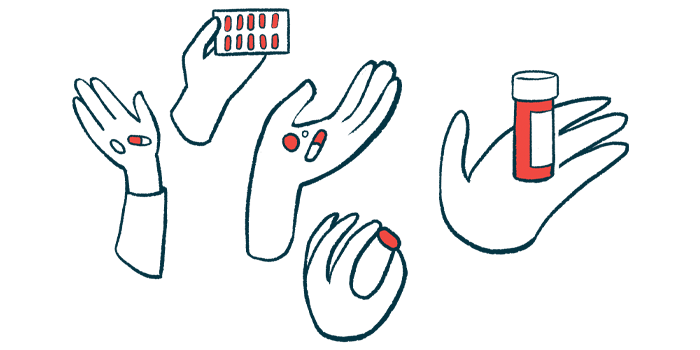Mavenclad found comparable to Gilenya in highly active MS
Real-world study shows therapies equally effective to reduce relapses

Mavenclad (cladribine) is equally as effective as Gilenya (fingolimod) in reducing relapse rates among multiple sclerosis (MS) patients with highly active disease, according to a new real-world comparison.
Disability worsening and the development of new lesions also were similar between the two patient groups — but researchers noted that more discontinuations or treatment switches occurred among those receiving Gilenya versus those taking Mavenclad.
“In this real-world retrospective … study, [Mavenclad] tablets demonstrated comparable effectiveness to [Gilenya] at one year following treatment initiation,” the researchers wrote, also noting that “the full treatment dosage of [Mavenclad] tablets is completed over two years and so these results may be conservative.”
The study, “Comparative effectiveness of cladribine tablets versus fingolimod in the treatment of highly active multiple sclerosis: A real-world study,” was published in the journal Multiple Sclerosis and Related Disorders.
1st head-to-head comparison of Mavenclad, Gilenya
Both Mavenclad, marketed by EMD Serono (known as Merck KGaA outside the U.S. and Canada), and Gilenya, by Novartis, are oral disease-modifying therapies — dubbed DMTs for short — approved for relapsing forms of MS. These two DMTs work to suppress the self-reactive immune response that targets and damages the nervous system and is the hallmark of MS.
In Europe, these are the only two oral treatments indicated for people who have highly active MS, as defined by certain clinical or imaging features. However, no clinical trials to date have made direct head-to-head comparisons between the two compounds.
Thus, researchers in the U.K. and Germany conducted an investigation, sponsored by EMD Serono, to compare the real-world effectiveness of Gilenya versus Mavenclad. The study, called MERLYN, was designed to assess whether Mavenclad, approved in the European Union in 2017, was at least as good as its older counterpart — Gilenya was approved in 2011 in the EU — in adults with highly active disease.
“Given the limited published evidence, it is important to obtain additional real-world comparative effectiveness data on these two oral DMTs,” the team wrote.
A total of 1,095 MS patients with highly active disease were enrolled and treated at 36 clinical sites across the two countries. All completed at least three months of treatment. The participants primarily identified as white patients (88.7%), had a mean age of 40, and were 70% female.
Of them, 610 (55.7%) were treated with Mavenclad and 485 (44.3%) with Gilenya.
Among the those who started on Mavenclad, 99.8% provided one year of follow-up data. One patient (0.2%) switched to another DMT.
By comparison, 3.5% of the Gilenya-treated patients did not provide the full year of data, either due to switching to another DMT (2.1%) or discontinuing treatment (1.4%). Also, 4.5% of patients on Gilenya had a treatment gap with a mean duration of 33.6 days, or just longer than one month.
“[Mavenclad] tablets was associated with fewer discontinuations or switching to another DMT compared with [Gilenya],” the researchers wrote.
Fewer treatment switches with Mavenclad vs Gilenya
In the year before starting treatment, 20.8% of patients in the Mavenclad group and 12.4% in the Gilenya group had experienced two or more physician-confirmed relapses.
Between three months and one year of treatment (nine months of follow-up), 6.9% of Mavenclad-treated patients had a relapse compared with 8.5% of those who received Gilenya. This translated into similar relapse rates, with patients on Mavenclad experiencing 0.1 relapses per year versus 0.14 relapses per year on Gilenya.
“It can be concluded that treatment with [Mavenclad] tablets is non-inferior [or at least as good] to [Gilenya],” the researchers wrote.
In both groups, the majority of patients who experienced a relapse had ones that were non-severe. Yet, twice as many patients on Gilenya than Mavenclad experienced a severe relapse leading to hospitalization (14.6% vs. 7.1%).
It can be concluded that treatment with [Mavenclad] tablets is non-inferior [or at least as good] to [Gilenya].
Disease severity before treatment, as assessed by the widely used Expanded Disability Status Scale (EDSS) — in which higher scores denote worse disability — was slightly worse among those who received Mavenclad than Gilenya (2.9 vs. 2.6). After six months to one year of treatment, the mean EDSS score did not change with Mavenclad and declined by 0.1 points with Gilenya, indicating less disability.
After one year of treatment, among those with MRI data, 21.1% in the Mavenclad group and 17.1% in the Gilenya group developed at least one new lesion. Lesions with active inflammatory activity were found in 8% of Mavenclad and 7.4% of Gilenya-treated patients.
Overall, findings from this real-world study demonstrated that Mavenclad tablets had “comparable effectiveness to [Gilenya] over a 9-month period” in RRMS patients with highly active disease, the researchers concluded, noting “discontinuations or treatment switching were greater in the [Gilenya] group.”







